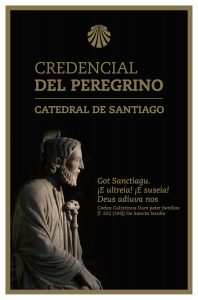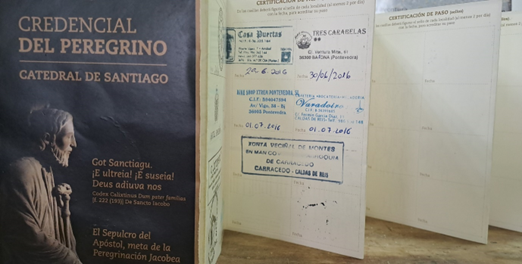The Credencial del Peregrino or Pilgrim´s Passport is a small booklet that you carry with you and get stamped along The Way. Its origins date back to the Middle Ages when the booklet was used quite literally as a passport to provide safe passage to pilgrims travelling to Santiago de Compostela. In those days it could be shown in exchange food and lodging for the night. You´ll not quite get that offered today, but it can get you a special rate both in hostels and for the Menu del Peregrino or Pilgrim´s Menu.
On arrival in Santiago de Compostela, present your Pilgrim´s Passport at the Pilgrim´s Office and in exchange you will receive a certificate – the Compostela. In order to get your Compostela you need to have travelled the final stretch of The Camino by foot, bicycle or on horseback. If you walk or are on horseback you need to travel the last 100km of The Camino. If you are cycling, they need to be the last 200km. You can also travel 100 nautical miles and then walk the last few kilometres of The Camino from O Monte do Gozo if your pilgrimage is by boat. You don´t have to do all of the last 100km/200km in one go. You can do it in stages but you must pick up from where you left off geographically – hence the need to get your stamps at each stage of your journey. There is only one official and valid credential which is the one issued by the Pilgrim´s Office in Santiago de Compostela. You will find it on Rua das Carretas just around the corner from the Plaza del Obradoiro.
You can pick up a Pilgrim´s Passport at the tourist office of your starting point. If you have booked your trip through us at The Way Experiences we will send one for each traveller in your group. It will be with your welcome pack waiting for you at your first hotel. Along your journey you can get your Pilgrim´s Passport stamped by hostels, hotels, bars, restaurants, town halls, local shops, churches etc. There are a total of 54 boxes for stamps in your Pilgrim´s Passport. If you are doing The Camino with children you will find they particularly love this aspect of the trip. As you make your journey along The Camino you should aim to get your Pilgrim´s Passport stamped at least a couple of times a day. You will see that each stamp is unique to the establishment that stamped it. It serves as a great reminder of the route you took. It doesn´t matter how many times you travel The Camino, your passport will look different every time. Looking back at my Pilgrim´s Passport from when I cycled The Portuguese Camino from Oporto in 2016, I see I even have one from a bike shop in Pontevedra. It serves as a great reminder of my journey. Where I ate, stayed and stopped for a coffee and got my bike repaired too!
At The Way Experiences we also offer The Epilogue journey from Santiago de Compostela to Finisterre and Muxia. This pilgrimage was officially recognised in the 1990s and has its own accreditation La Fisterrana and La Muxiana. It works in the same way as the Pilgrim´s Passport and the Compostela. If you are continuing your journey and still have room in your Pilgrim´s Passport you can continue to use this one. Otherwise you can pick up a new one in The Pilgrim´s Office in Santiago de Compostela. When you arrive in Finisterre you can pick up your Fisterrana certificate at the Albergue (hostel) de Fisterra. For the Muxiana, continue your journey and collecting your stamps through Negreira, Olvieroa, Fisterra or Lires and pick up your certificate at the tourist office in Muxia. You can also do the journey in reverse and starting in Muxia and ending in Santiago de Compostela.
In recent years, due to popular demand, the Pilgrim´s Office in Santiago can also issue you with a Certificado de Distancia (Certificate of Distance). This slightly larger certificate certifies the total number of kilometres you have travelled from your starting point. This indicates the day and starting point of your pilgrimage, the number of kilometres covered, the day of arrival in Santiago and the route of your pilgrimage. This can also be backdated if you wish to apply for one.
¡Buen Camino!


